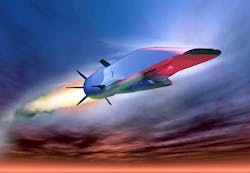Surface damage to vehicles traveling at hypersonic speeds from ice and dust particles
URBANA-CHAMPAIGN, Ill., - Vehicles moving at hypersonic speeds are bombarded with ice crystals and dust particles in the surrounding atmosphere, making the surface material vulnerable to damage such as erosion and sputtering with each tiny collision. Researchers at the University of Illinois at Urbana-Champaign studied this interaction one molecule at a time to understand the processes, then scaled up the data to make it compatible with simulations that require a larger scale, according to SciTechDaily.com.
Continue reading original articleThe Intelligent Aerospace take:
January 13, 2020 -Engineers in both military and civilian sectors have their eyes on a future of hypersonic flight. Doctoral student Neil Mehta working with Prof. Deborah Levin at the University of Illinois explored a pair of materials - graphene and quartz - that are commonly used on the exterior of slender bodies. Using molecular dynamics, Mehta studied the damage done at the size of a single angstrom - which is roughly the size of an atom - when ice and silica particles strike a vehicle moving at hypersonic speeds.
“At what rate will these processes happen and with what likelihood will these types of damages happen were the key features that no other Kinetic Monte Carlo or scale bridging has used before,” said Mehta, whose study is linked in the story above.
Related: Hypersonic flight technology just passed a 'hugely significant' milestone
Related: Military researchers seek to counter threats from enemy hypersonic missiles and aircraft
Jamie Whitney, Associate Editor
Intelligent Aerospace
